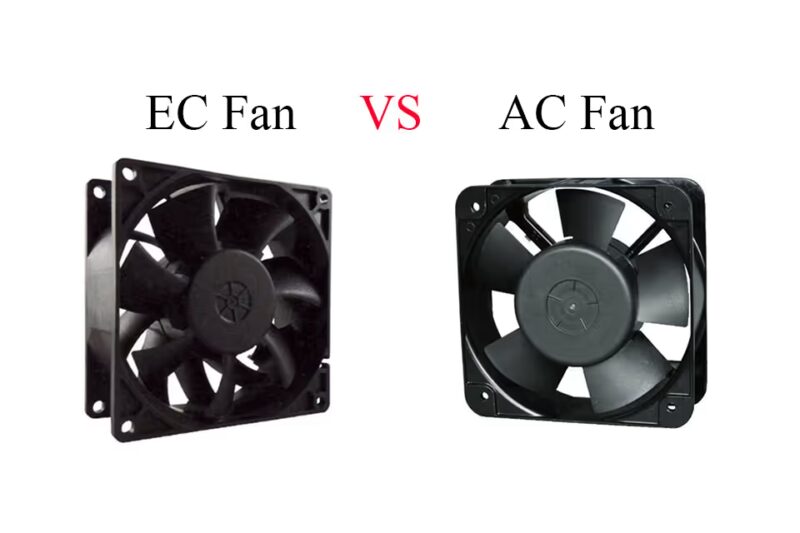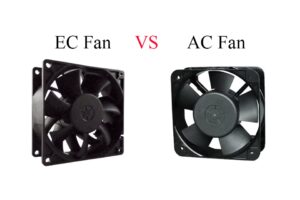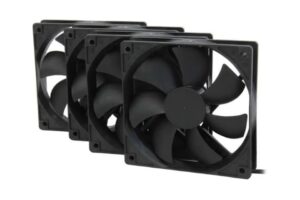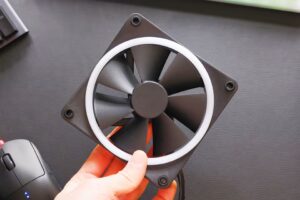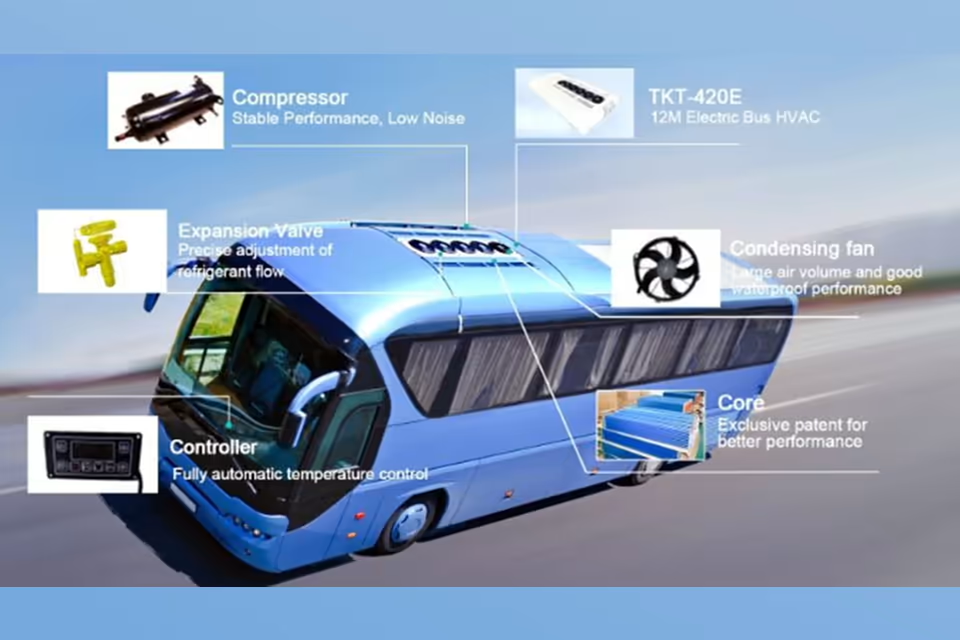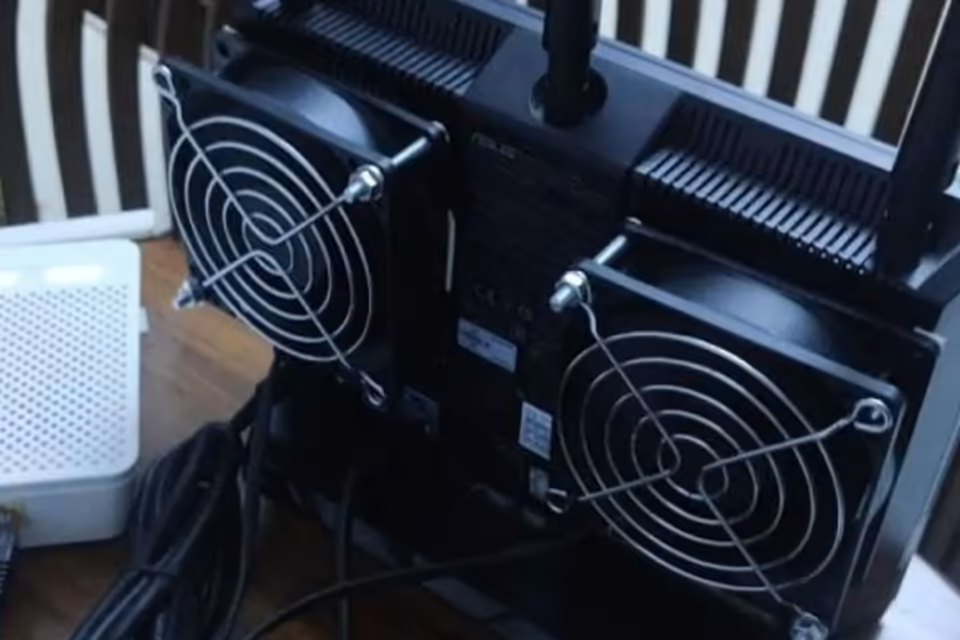Der Vergleich zwischen elektronisch kommutierten (EC) Ventilatoren und Wechselstrom (AC) Ventilatoren ist in Diskussionen über Energieeffizienz und Nachhaltigkeit in verschiedenen Branchen, insbesondere in der HLK, Kältetechnik und in Rechenzentren, immer relevanter geworden.
EC-Ventilatoren, die fortschrittliche elektronische Steuerungen zur Optimierung des Stromverbrauchs nutzen, gewinnen aufgrund ihrer überlegenen Energieeffizienz – bis zu 90 % im Vergleich zu den typischen 70 % von AC-Ventilatoren – an Bedeutung, was sie zu einer bevorzugten Option für umweltbewusste Verbraucher und Unternehmen gleichermaßen macht. Da die Energiekosten steigen und Vorschriften strenger werden, spiegelt die Verlagerung hin zu EC-Ventilatoren einen wachsenden Trend zu nachhaltigen Praktiken im Gebäudemanagement und in industriellen Anwendungen wider.
EC-Ventilatoren zeichnen sich durch ihre Fähigkeit aus, den Stromverbrauch dynamisch an die betrieblichen Anforderungen anzupassen, was zu einem reduzierten Energieverbrauch und niedrigeren Betriebskosten über die Zeit führt. Sie bieten auch erhebliche Vorteile bei der Geräuschreduzierung, den Wartungsanforderungen und der Langlebigkeit, was sie trotz höherer Anfangsinvestitionen langfristig kostengünstiger machen kann.
Im Gegensatz dazu sind AC-Ventilatoren, obwohl sie in der Anschaffung in der Regel günstiger sind, durch ihren Betrieb mit fester Drehzahl und ihren höheren Energieverbrauch begrenzt, was in energieempfindlichen Anwendungen zu erhöhten Betriebskosten führen kann.
Die Umweltauswirkungen dieser Technologien unterstreichen ihre Bedeutung zusätzlich, da EC-Ventilatoren zu geringeren Treibhausgasemissionen und einer besseren Raumluftqualität beitragen.
Die Marktdynamik entwickelt sich jedoch weiter, mit zunehmendem Druck auf AC-Ventilatoren, sich an neue Energieeffizienzstandards anzupassen, inmitten des wachsenden Wettbewerbs durch die fortschrittlicheren EC-Ventilatoren.
Da Nachhaltigkeit weiterhin die Verbraucherpräferenzen und regulatorischen Rahmenbedingungen prägt, dient der ultimative Vergleich zwischen EC-Ventilatoren und AC-Ventilatoren als entscheidender Brennpunkt für das Verständnis der Zukunft energieeffizienter Technologien.
EC-Ventilatoren
Elektronisch kommutierte (EC) Ventilatoren haben sich als Schlüsseltechnologie in verschiedenen Anwendungen etabliert, insbesondere in der Kältetechnik, HLK-Systemen und Klimaanlagen für Computerräume. Die steigende Nachfrage nach EC-Ventilatoren ist eng mit dem Aufkommen von Smart Buildings und Smart Homes sowie einem verstärkten Fokus auf Energieeinsparung und Nachhaltigkeit verbunden.
Diese Ventilatoren sind für ihre überlegene Energieeffizienz bekannt, die nicht nur die Betriebskosten senkt, sondern auch die Umweltbelastung reduziert, was sie zu einer attraktiven Wahl für Unternehmen und Hausbesitzer macht, die effiziente Lösungen suchen.
Vorteile von EC-Ventilatoren
Energie-Effizienz
Einer der Hauptvorteile von EC-Ventilatoren ist ihre außergewöhnliche Energieeffizienz. Im Gegensatz zu herkömmlichen AC-Ventilatoren, die unabhängig von den betrieblichen Anforderungen eine konstante Energiemenge verbrauchen, können EC-Ventilatoren ihren Stromverbrauch an die aktuellen Anforderungen des Systems anpassen.
Diese Fähigkeit führt zu einem geringeren Gesamtenergieverbrauch und erheblichen Kosteneinsparungen über die Zeit. Darüber hinaus trägt ihre hohe Effizienz zu einer reduzierten Wärmeabgabe bei, was die Langlebigkeit und Leistung des gesamten Systems verbessert.
Kosteneffizienz
Obwohl EC-Ventilatoren eine höhere Anfangsinvestition erfordern können, erweisen sie sich aufgrund ihrer energiesparenden Eigenschaften und Langlebigkeit oft als langfristig wirtschaftlicher. Dies macht sie besonders attraktiv in Szenarien, in denen ein konstanter Betrieb erforderlich ist, wie zum Beispiel in Häusern mit hohen Radonwerten.
Additionally, their low operating costs and short payback periods make them a financially viable option for many users.
Geräuschreduzierung
In residential applications, fan noise can be a significant concern, especially when located near living spaces or bedrooms.
Traditional AC fans can generate noticeable noise, whereas EC fans are engineered with noise reduction in mind. Their quieter motors and variable speed capabilities allow them to operate more softly when full power isn’t required, which enhances indoor comfort for homeowners who prioritize a peaceful living environment.
Wartung und Zuverlässigkeit
EC fans offer reduced maintenance requirements compared to their AC counterparts. Traditional belt-driven fans often necessitate frequent inspections and component replacements, leading to higher maintenance costs and potential downtime.
In contrast, EC fans are designed with a direct-drive system that eliminates common failure points associated with belts and pulleys. This simplicity not only lowers maintenance needs but also facilitates precise speed control without relying on external Variable Frequency Drives (VFDs).
Umweltauswirkungen
The environmental implications of using EC fans versus traditional AC fans are significant, particularly in the context of energy consumption and greenhouse gas emissions.
Conventional temperature regulation methods often rely on refrigerants with high global warming potential (GWP), which contribute substantially to climate change. Studies have shown that some refrigerants have a GWP that is thousands of times greater than that of carbon dioxide, necessitating a shift towards more sustainable cooling solutions.
EC fans are designed to consume up to 50% less electricity compared to traditional AC motors, thereby not only lowering operational costs but also reducing their overall environmental footprint.
This reduction in energy consumption translates into lower greenhouse gas emissions and supports compliance with stringent environmental regulations aimed at decreasing carbon emissions and energy use in various sectors, including HVAC systems.
For instance, the adoption of EC blowers and fans has gained traction due to policies like the Ecodesign Directive in Europe, which sets energy efficiency standards for electric motors and fans, fostering a market shift towards energy-efficient solutions.
Moreover, the use of EC fans can contribute to better indoor air quality and efficient temperature regulation, which are increasingly important factors for consumers and businesses alike.
As the demand for sustainable and energy-efficient HVAC solutions rises, the market for EC fans is expected to continue to grow. This growing focus on sustainability is crucial in the context of building energy consumption, with HVAC and ventilation systems accounting for approximately 13% of overall building energy use.
By aligning product offerings with environmental standards, manufacturers can capitalize on the increasing demand for energy-efficient technologies while contributing positively to environmental sustainability.
AC-Ventilatoren
AC fans are widely utilized in various applications due to their straightforward design and cost-effectiveness. They operate on alternating current (AC) and are known for their ability to provide strong, steady airflow, making them suitable for large spaces such as factories, greenhouses, and control boxes where consistent air movement is essential.
One of the significant advantages of AC fans is their lower initial purchase cost, which can be 10-75% less compared to their electronically commutated (EC) counterparts.
Einschränkungen von AC-Ventilatoren
Despite their affordability, AC fans come with certain limitations. Their fixed-speed nature restricts advanced control options, which can hinder integration with smart systems.
As the demand for energy-efficient solutions grows, the relatively higher energy consumption of AC fans—compared to EC fans—becomes a drawback. AC fans can lead to higher operational costs, especially in environments where energy efficiency is a priority.
Anwendungen und Eignung
AC fans are best suited for applications where speed variation is not frequently required. They excel in situations that demand robust airflow without the need for intricate controls, making them a go-to choice for standard cooling requirements.
For instance, industries often employ AC fans in scenarios where energy savings are less critical than reliability and performance.
Markttrends und zukünftige Überlegungen
As the market for energy-efficient technologies continues to expand, especially within the green building sector, there is growing pressure on manufacturers to innovate and adapt.
Regulatory compliance and the push for energy-efficient solutions are driving factors that could influence the future adoption of AC fans, especially as alternative technologies, such as EC fans, gain popularity due to their superior energy efficiency.
Therefore, while AC fans remain a practical choice for many applications today, their long-term viability may be challenged by evolving consumer preferences and stricter energy standards.
Vergleich von EC-Ventilatoren und AC-Ventilatoren
EC fans and AC fans differ significantly in terms of energy efficiency, design, operational costs, and maintenance requirements. Understanding these distinctions is crucial for selecting the appropriate fan for specific applications.
Energie-Effizienz
One of the most notable advantages of EC fans is their energy efficiency. EC fans can achieve efficiency levels of up to 90%, whereas AC fans typically operate at lower efficiency rates, generally around 70%.
This means that EC fans not only consume less energy but also reduce heat loss, leading to longer equipment lifespans and lower operating costs over time. The energy savings become even more pronounced when multiple EC fans are used in conjunction.
Design und Größe
In terms of design, EC fans are generally more compact and lighter than their AC counterparts, making them ideal for applications with space constraints. Their smaller size facilitates easier integration into existing systems without extensive modifications, which is particularly beneficial in retrofit projects in older buildings.
Betriebseigenschaften
AC fans usually operate in a binary manner—either fully on or off. In contrast, EC fans are capable of variable speed operation, allowing for precise control over airflow and energy consumption. This capability enhances comfort and system balance in various environments, especially in settings requiring consistent airflow.
Moreover, the direct-drive design of EC fans eliminates many common failure points associated with belt-driven systems, resulting in improved reliability and reduced maintenance demands.
Wartungsanforderungen
EC fans offer significant advantages regarding maintenance. Traditional AC fans, especially those that are belt-driven, require frequent inspections, realignment, and periodic replacement of belts and bearings.
In contrast, the direct-drive system of EC fans minimizes mechanical issues and reduces maintenance costs by eliminating the need for belts and pulleys, thus enhancing their operational reliability.
The onboard electronics in EC fans also facilitate precise speed control without external Variable Frequency Drives (VFDs), further simplifying their operation.
Geräuschpegel
Another benefit of EC fans is their quiet operation. Operating with minimal sound, they are particularly suitable for residential and commercial environments where noise levels are a concern. This characteristic makes EC fans a favorable choice for sensitive applications such as hospitals and libraries, where maintaining a serene atmosphere is essential.
Applications
EC fans are increasingly recognized for their versatility and efficiency across a wide range of industries and applications. Their ability to provide precise control over airflow and energy consumption makes them a preferred choice in various sectors, including HVAC, refrigeration, and data centers.
HVAC Systems
One of the primary applications of EC fans is in HVAC systems, where they are utilized to enhance indoor air quality and comfort. These fans are widely adopted in commercial buildings such as offices, shopping malls, and hotels, where efficient ventilation is critical. Their energy-efficient operation helps reduce operational costs while meeting the growing demand for sustainable building practices.
The compact design and quiet operation of EC fans make them particularly suitable for installations in environments that require minimal noise, such as libraries and hospitals.
Kältetechnik
In the refrigeration sector, EC fan motors are employed in various applications, including commercial refrigeration units, ice machines, and industrial cold storage systems. Their ability to maintain consistent airflow and temperature while consuming less energy is crucial for the food and beverage industry, where efficient refrigeration is paramount.
With the stringent regulations on energy consumption and efficiency in refrigeration, the adoption of EC fan motors is expected to continue rising, further driving market growth in this segment.
Rechenzentren
The data center industry represents one of the fastest-growing markets for EC fans. As the demand for efficient cooling solutions increases to maintain optimal operating temperatures for servers and electronic equipment, EC fans provide precise airflow control, enhancing cooling efficiency while reducing energy consumption.
Their integration with building automation systems and IoT devices further optimizes the performance of cooling systems in data centers, aligning with the growing trends of cloud computing and big data analytics.
Industrielle Anwendungen
EC fans are also finding applications in industrial settings, including manufacturing and automotive sectors. Industries are increasingly adopting these modern ventilation solutions to improve operational efficiency and comply with evolving energy regulations.
The versatility of EC fans allows them to be customized for various industrial processes, contributing to lower energy costs and enhanced productivity.
Zukünftige Trends
The future outlook for the EC blowers and fans market is highly optimistic, driven by the increasing demand for energy-efficient and sustainable air-moving solutions.
As industries continue to prioritize energy efficiency, the adoption of Electronically Commutated (EC) fans is expected to rise significantly in various sectors, including HVAC, automotive, and industrial applications. The shift towards electric vehicles in the automotive sector necessitates efficient cooling systems, further boosting the demand for EC fans.
Marktwachstumsfaktoren
Several factors are contributing to the anticipated growth in the EC fans market. The integration of IoT and smart building technologies is a key driver, enabling businesses to optimize performance and reduce energy consumption.
These technologies allow for enhanced control and monitoring of HVAC systems, making EC fans an attractive option for modern building designs. Additionally, the increased regulatory emphasis on energy efficiency and sustainability, such as California’s Title 24 Building Energy Efficiency Standards, is propelling market penetration for EC fans.
Segment-Einblicke
Market segmentation highlights significant trends within the EC fans industry. The brushless motor segment is particularly noteworthy, accounting for over 40% of the Electronically Commutated Machine market revenue in 2023.
This growing preference reflects the advantages of EC motors, such as quieter operation and superior performance at variable speeds. The industrial sector is also projected to represent a substantial share of the market, indicating a broad application for EC technologies across various industries.
Regulatorische und technologische Fortschritte
The regulatory landscape continues to evolve, incentivizing the adoption of energy-efficient technologies. Compliance with new regulations can unlock federal and state incentives, reducing the total cost of ownership for end-users.
This trend creates a favorable environment for the proliferation of EC fans, especially in the green building sector, which is expected to constitute a significant portion of new commercial construction by 2030.
Technological advancements in fan design and motor technology are further propelling market growth. The development of advanced EC motors with integrated electronics and variable speed drives enhances performance, reliability, and lifespan, making them more appealing to consumers.

